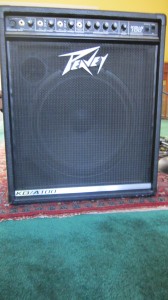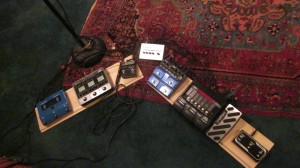
Bringing out the Low End with the Big Amp
I’ve been working with the two-amp-modeler Zoom G3 + Digitech RP355 setup for long enough now to know that my Peavey KB2 amp, with its brave but outgunned 10 inch speaker, isn’t going to cut it for the super-saturated low end frequencies that I’m laying down with this setup. So I’ve switched to my Peavey KB/A 100, which has more power and a 15″ woofer–big enough to handle all the low end I can throw at it.

The main difference this makes in the rig is that the super-low frequencies I’m generating with multiple octave dividers don’t make the speaker crap out anymore. It also makes the rig heavier by about 20 pounds, but I guess my car can handle that, even if my back struggles to do so.
Not satisfied with upgrading the amp, I laid out a proof-of-concept pedal board this weekend; I bought a board, 1″ by 8″ by 6 feet, and cut it down to two boards, 29″ long each. I then velcro’d the pedals to the boards. Here’s what it looks like.

Putting the pedals on these things does a few things for me. First, it stabilizes the pedals, because they’re now mounted on something bigger and heavier, so they don’t move around. Second, I can scale the rig up and down quickly and easily. I can do two kinds of performances using just the right-side board: a typical band gig, where I use the RP355 alone; and a minimal solo gig, where I use just the RP355 and the JamMan Stereo. For a full-blown everything-I-can-do gig, where I want as much sheer sound-generating power as possible, I can take both the boards.
This must be getting serious if I’m figuring out how to put the stuff on stage and keep it there. Stay tuned for more on the evolving rig.
Related Posts
Leave a Reply
You must be logged in to post a comment.
WHAT’S NEW
Categories
- Audio/Video
- Blog
- Blue Future
- Digitech RP Tricks and Tips
- Discography, CDs, Projects, Info, Notes
- Featured Video
- For the Beginner
- Gallery
- Hunter's Effects
- Hunter's Music
- Huntersounds for Fender Mustang
- Meet the Pros
- More Video
- MPH: Maw/Preston/Hunter
- My Three Big Contributions
- Player's Resources
- Pro Tips & Techniques
- Recommended Artists & Recordings
- Recommended Gear
- Recorded Performances
- Reviews, Interviews, Testimonials
- The Lucky One
- Uncategorized
- Upcoming Performances
- Zoom G3 Tips and Tricks